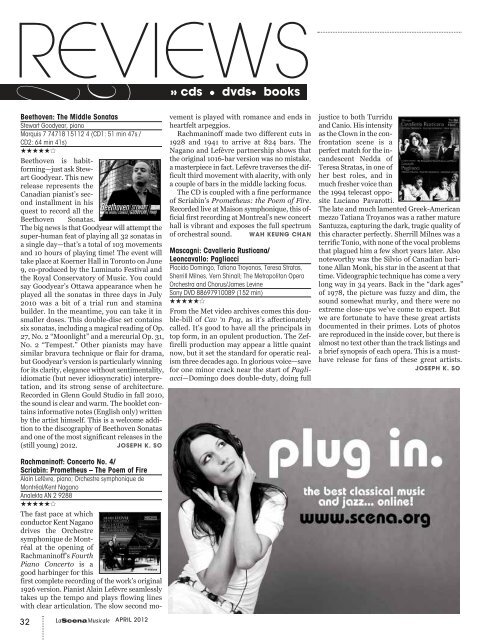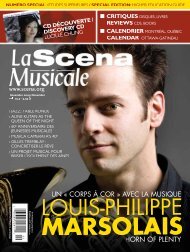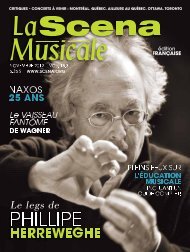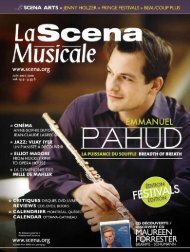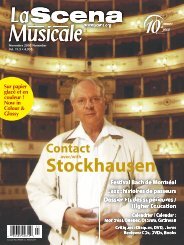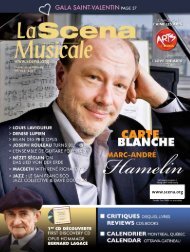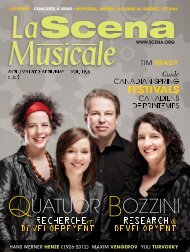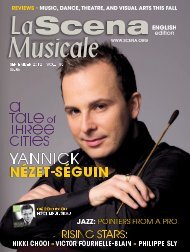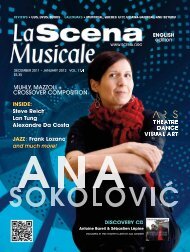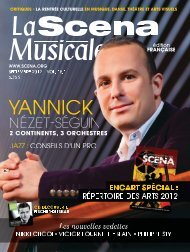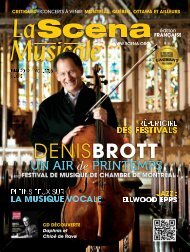The Bohlen-Pierce system - La Scena Musicale
The Bohlen-Pierce system - La Scena Musicale
The Bohlen-Pierce system - La Scena Musicale
Create successful ePaper yourself
Turn your PDF publications into a flip-book with our unique Google optimized e-Paper software.
REVIEWS<br />
» cds • dvds• books<br />
Beethoven: <strong>The</strong> Middle Sonatas<br />
Stewart Goodyear, piano<br />
Marquis 7 74718 15112 4 (CD1: 51 min 47s /<br />
CD2: 64 min 41s)<br />
★★★★★✩<br />
Beethoven is habitforming—just<br />
ask Stewart<br />
Goodyear. This new<br />
release represents the<br />
Canadian pianist’s second<br />
installment in his<br />
quest to record all the<br />
Beethoven Sonatas.<br />
<strong>The</strong> big news is that Goodyear will attempt the<br />
super-human feat of playing all 32 sonatas in<br />
a single day—that’s a total of 103 movements<br />
and 10 hours of playing time! <strong>The</strong> event will<br />
take place at Koerner Hall in Toronto on June<br />
9, co-produced by the Luminato Festival and<br />
the Royal Conservatory of Music. You could<br />
say Goodyear’s Ottawa appearance when he<br />
played all the sonatas in three days in July<br />
2010 was a bit of a trial run and stamina<br />
builder. In the meantime, you can take it in<br />
smaller doses. This double-disc set contains<br />
six sonatas, including a magical reading of Op.<br />
27, No. 2 “Moonlight” and a mercurial Op. 31,<br />
No. 2 “Tempest.” Other pianists may have<br />
similar bravura technique or flair for drama,<br />
but Goodyear’s version is particularly winning<br />
for its clarity, elegance without sentimentality,<br />
idiomatic (but never idiosyncratic) interpretation,<br />
and its strong sense of architecture.<br />
Recorded in Glenn Gould Studio in fall 2010,<br />
the sound is clear and warm. <strong>The</strong> booklet contains<br />
informative notes (English only) written<br />
by the artist himself. This is a welcome addition<br />
to the discography of Beethoven Sonatas<br />
and one of the most significant releases in the<br />
(still young) 2012.<br />
JOSEPH K. SO<br />
Rachmaninoff: Concerto No. 4/<br />
Scriabin: Prometheus – <strong>The</strong> Poem of Fire<br />
Alain Lefèvre, piano; Orchestre symphonique de<br />
Montréal/Kent Nagano<br />
Analekta AN 2 9288<br />
★★★★★✩<br />
<strong>The</strong> fast pace at which<br />
conductor Kent Nagano<br />
drives the Orchestre<br />
symphonique de Montréal<br />
at the opening of<br />
Rachmaninoff’s Fourth<br />
Piano Concerto is a<br />
good harbinger for this<br />
first complete recording of the work’s original<br />
1926 version. Pianist Alain Lefèvre seamlessly<br />
takes up the tempo and plays flowing lines<br />
with clear articulation. <strong>The</strong> slow second movement<br />
is played with romance and ends in<br />
heartfelt arpeggios.<br />
Rachmaninoff made two different cuts in<br />
1928 and 1941 to arrive at 824 bars. <strong>The</strong><br />
Nagano and Lefèvre partnership shows that<br />
the original 1016-bar version was no mistake,<br />
a masterpiece in fact. Lefèvre traverses the difficult<br />
third movement with alacrity, with only<br />
a couple of bars in the middle lacking focus.<br />
<strong>The</strong> CD is coupled with a fine performance<br />
of Scriabin’s Prometheus: the Poem of Fire.<br />
Recorded live at Maison symphonique, this official<br />
first recording at Montreal’s new concert<br />
hall is vibrant and exposes the full spectrum<br />
of orchestral sound. WAH KEUNG CHAN<br />
Mascagni: Cavalleria Rusticana/<br />
Leoncavallo: Pagliacci<br />
Placido Domingo, Tatiana Troyanos, Teresa Stratas,<br />
Sherrill Milnes, Vern Shinall; <strong>The</strong> Metropolitan Opera<br />
Orchestra and Chorus/James Levine<br />
Sony DVD 88697910089 (152 min)<br />
★★★★★✩<br />
From the Met video archives comes this double-bill<br />
of Cav ‘n Pag, as it’s affectionately<br />
called. It’s good to have all the principals in<br />
top form, in an opulent production. <strong>The</strong> Zeffirelli<br />
production may appear a little quaint<br />
now, but it set the standard for operatic realism<br />
three decades ago. In glorious voice—save<br />
for one minor crack near the start of Pagliacci—Domingo<br />
does double-duty, doing full<br />
justice to both Turridu<br />
and Canio. His intensity<br />
as the Clown in the confrontation<br />
scene is a<br />
perfect match for the incandescent<br />
Nedda of<br />
Teresa Stratas, in one of<br />
her best roles, and in<br />
much fresher voice than<br />
the 1994 telecast opposite<br />
Luciano Pavarotti.<br />
<strong>The</strong> late and much lamented Greek-American<br />
mezzo Tatiana Troyanos was a rather mature<br />
Santuzza, capturing the dark, tragic quality of<br />
this character perfectly. Sherrill Milnes was a<br />
terrific Tonio, with none of the vocal problems<br />
that plagued him a few short years later. Also<br />
noteworthy was the Silvio of Canadian baritone<br />
Allan Monk, his star in the ascent at that<br />
time. Videographic technique has come a very<br />
long way in 34 years. Back in the “dark ages”<br />
of 1978, the picture was fuzzy and dim, the<br />
sound somewhat murky, and there were no<br />
extreme close-ups we’ve come to expect. But<br />
we are fortunate to have these great artists<br />
documented in their primes. Lots of photos<br />
are reproduced in the inside cover, but there is<br />
almost no text other than the track listings and<br />
a brief synopsis of each opera. This is a musthave<br />
release for fans of these great artists.<br />
JOSEPH K. SO<br />
32<br />
APRIL 2012


